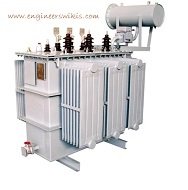
Overvoltage protection is essential for safeguarding transformers against voltage surges that exceed their rated voltage levels. Voltage surges can be caused by various factors, such as lightning strikes, switching operations, or system faults. Methods and devices used for overvoltage protection of transformers are as below:
- Surge Arresters: Surge arresters, also known as lightning arresters, are widely used for overvoltage protection. They are installed at the incoming terminals of the transformer to divert excessive voltage surges to the ground. Surge arresters consist of metal-oxide varistors (MOVs) or other nonlinear resistors that provide high impedance under normal voltage conditions but quickly conduct when the voltage exceeds a certain threshold. This redirects the surge current away from the transformer, protecting it from the damaging effects of overvoltage.
- Voltage Regulators: Voltage regulators are devices that maintain a steady output voltage within a specified range, regardless of fluctuations in the input voltage. They can be used to regulate the voltage supplied to the transformer, ensuring that it does not exceed the rated voltage. Voltage regulators can be manual or automatic, adjusting the output voltage based on control signals or feedback mechanisms.
- Transformer Tap Changers: Tap changers are used in transformers to adjust the turns ratio and, consequently, the output voltage. By changing the tap position, the transformer’s output voltage can be adjusted to compensate for variations in the system voltage. During periods of overvoltage, tap changers can be used to lower the output voltage and protect the transformer from excessive stress.
- Voltage Monitoring Relays: Voltage monitoring relays continuously monitor the input voltage to the transformer. If the voltage exceeds a predetermined threshold, the relay can initiate protective actions, such as tripping circuit breakers or sending an alarm signal. Voltage monitoring relays provide an additional layer of protection by detecting and responding to overvoltage conditions.
- System Protection Devices: In addition to specific transformer protection devices, overall system protection devices play a crucial role in preventing overvoltage events. These devices include circuit breakers, fuses, and protective relays that are coordinated to detect and isolate faults or abnormal voltage conditions in the power system. Proper coordination and settings of these devices ensure that overvoltage events are promptly detected and mitigated, protecting the transformer and other equipment.
It’s important to note that a combination of these protective measures is often employed to ensure comprehensive overvoltage protection for transformers. The specific protection methods and devices chosen depend on factors such as the transformer’s rating, location, and the characteristics of the electrical system in which it operates. Proper installation, maintenance, and periodic testing of the protective devices are crucial to ensure their effectiveness in mitigating overvoltage risks and safeguarding transformers.
